Introduction
In the rapidly evolving landscape of modern business, organizations are increasingly turning to Robotic Process Automation (RPA) as a powerful solution to streamline operations and enhance productivity. By automating repetitive and rule-based tasks, RPA not only alleviates staffing challenges but also empowers employees to focus on more strategic initiatives. However, to fully leverage the potential of RPA, a clear understanding of its lifecycle is essential—from identifying suitable processes for automation to monitoring performance post-implementation.
This article delves into the intricacies of RPA, exploring its lifecycle, the essential stages for successful implementation, and the metrics that drive its effectiveness. By addressing common challenges and embracing future trends, organizations can cultivate a culture of automation that propels them toward sustained operational excellence.
Understanding Robotic Process Automation (RPA) and Its Lifecycle
Robotic Process Automation (RPA) transforms how entities manage routine and repetitive tasks, significantly enhancing efficiency and productivity. By leveraging innovative tools like EMMA RPA and Microsoft Power Automate, organizations can transform operations, overcome staffing shortages, and enhance employee morale. Grasping the RPA lifecycle is crucial for effective implementation and optimizing the advantages of mechanization. This lifecycle includes several stages, each essential for aligning RPA solutions with organizational objectives.
The first stage involves identifying processes prime for automation, focusing on repetitive, rule-based, and high-volume tasks. Next, the development phase encompasses designing and building the RPA solution tailored to these identified processes. Once developed, the solution enters the testing stage, where it is rigorously evaluated for accuracy and reliability.
Deployment follows, integrating the RPA solution into the operational environment. After deployment, ongoing monitoring and maintenance are crucial to ensure the solution stays effective and adjusts to any changes in operational processes.
Recent advancements in RPA technology have streamlined this lifecycle, incorporating sophisticated analytics and AI capabilities to enhance process identification and optimization. In 2024, RPA adoption surged, with reports indicating a 30% increase in implementation across various industries, as companies leverage these technologies to tackle more complex and dynamic tasks. This surge underscores the importance of RPA in enhancing operational efficiency and addressing staffing challenges.
Moreover, understanding the personal data processing notice issued by Defra is crucial, as it outlines how personal data related to financial transactions is managed, including any potential offshore processing by its service provider. This knowledge is vital for ensuring RPA implementation complies with data protection regulations, thereby safeguarding sensitive information.
By meticulously following the RPA lifecycle, organizations can implement robust solutions that drive efficiency, increase accuracy, and ultimately deliver substantial business value. This comprehensive strategy enables operations directors to make informed choices, ensuring the success of their projects.
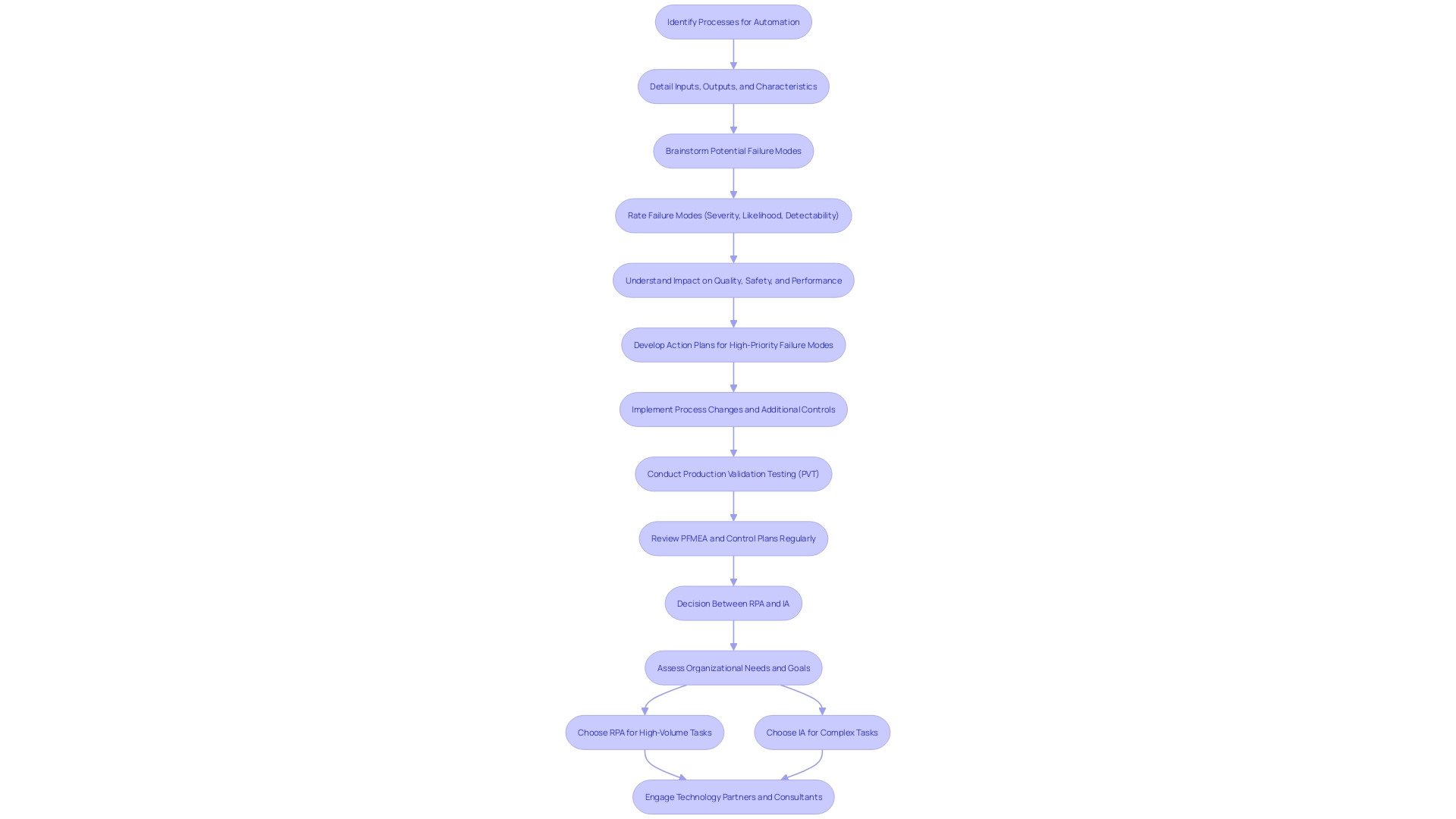
The Six Essential Stages of the RPA Life Cycle
Are you ready to revolutionize your operations? Recognizing procedures for mechanization is the crucial first step in the RPA lifecycle. This stage involves pinpointing tasks that are repetitive, rule-based, and high in volume, such as:
- Invoice processing
- Customer onboarding
- Data entry
By assessing their operations, organizations can identify which tasks are prime candidates for mechanization, thereby addressing common workplace challenges like staffing shortages and outdated systems. Our RPA solutions can significantly enhance these tasks, streamlining operations and boosting efficiency.
For instance, a recent case study illustrated how a mid-sized company enhanced efficiency by mechanizing:
- Data entry
- Software testing
- Legacy system integration through GUI processes
They encountered obstacles like manual data entry mistakes and sluggish software testing, but after adopting automated solutions, they accomplished a 70% decrease in data entry errors and a 50% increase in testing speeds, leading to an 80% enhancement in workflow efficiency. Such measurable outcomes underscore the importance of identifying and automating suitable processes.
According to a report by Grand View Research, the global process optimization market is expected to reach $19.6 billion by 2026, expanding at a CAGR of 12.2% from 2019 to 2026. This growth emphasizes the rising demand for organizations to utilize AI-driven operational process enhancement for tasks such as:
- Data extraction
- Process discovery
- Predictive analytics
- Customer service
RPA developers play a crucial role in this stage, as they design the ecosystem for deploying bots, monitor performance, and integrate with existing technologies. Recent advancements in process identification techniques, such as machine learning algorithms and advanced analytics, empower organizations to analyze historical data and pinpoint inefficiencies, ensuring that automation efforts deliver maximum benefits.
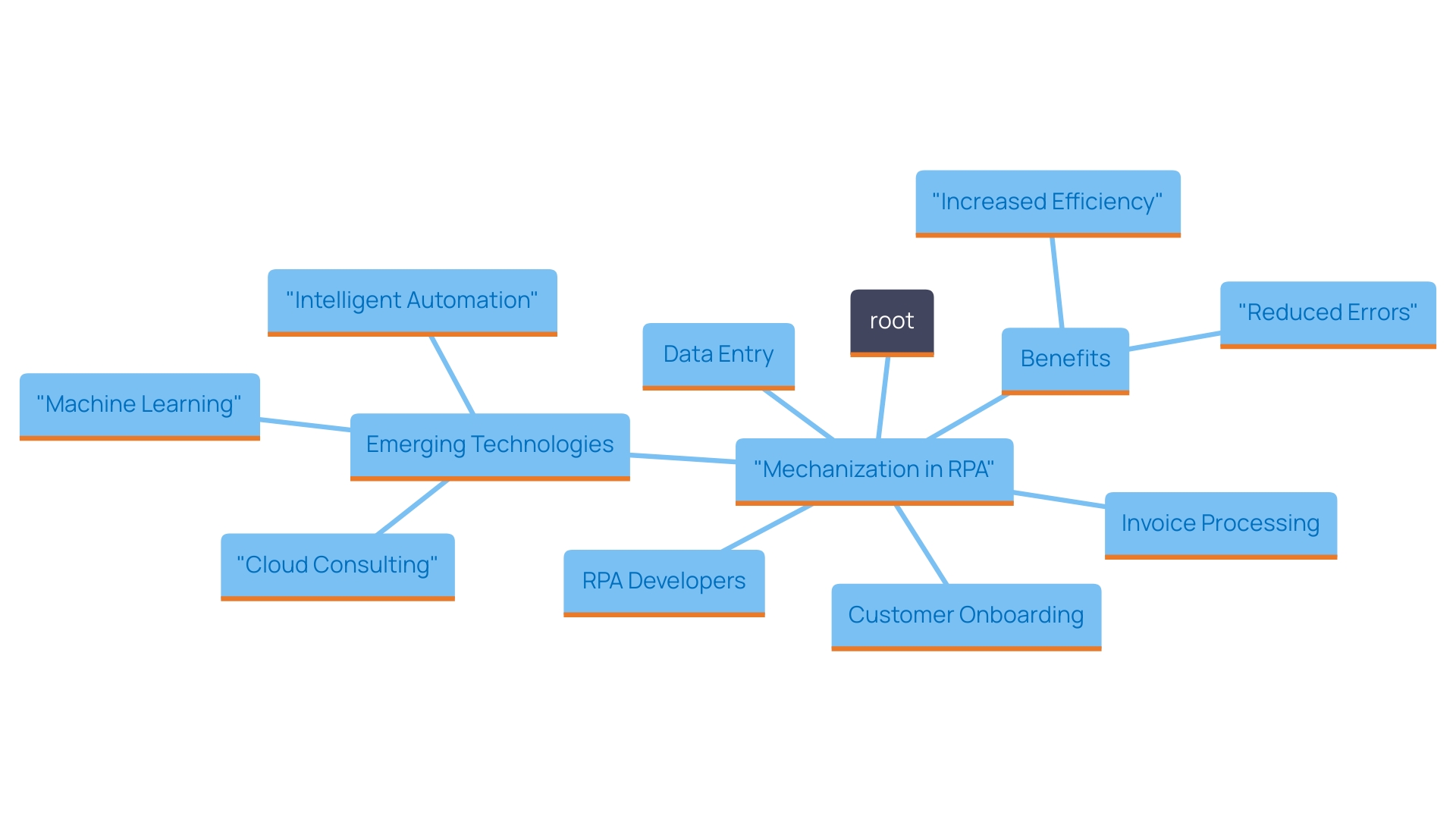
Overcoming Challenges in RPA Implementation
Implementing RPA can present several challenges, including resistance to change from employees, technical issues, and insufficient alignment with organizational goals. To overcome these obstacles:
- Engage Stakeholders: Involve key stakeholders early in the process to gain buy-in and support for RPA initiatives, thereby enhancing efficiency and addressing technology implementation challenges. For example, a manufacturing company that engaged its frontline workers in the RPA planning process saw a 30% increase in adoption rates.
- Provide Training: Invest in training programs that ensure employees feel comfortable with the new technology and understand its benefits. By empowering your team with knowledge, you can boost morale and facilitate a smoother transition. Case studies indicate that entities that provided comprehensive training experienced a 40% reduction in operational errors post-implementation.
- Establish Clear Metrics: Define success metrics from the outset to measure the impact of RPA on operational efficiency. This includes utilizing intelligence to transform raw data into actionable insights that drive informed decision-making. For instance, a financial services firm that implemented RPA with clear KPIs reported a 25% increase in processing speed and a significant reduction in manual errors.
By proactively tackling these challenges and concentrating on customized AI solutions, organizations can create a smoother shift to mechanization and maximize the benefits of RPA. This strategic approach not only drives growth and innovation but also enhances overall operational efficiency, making RPA a critical component of modern business success.
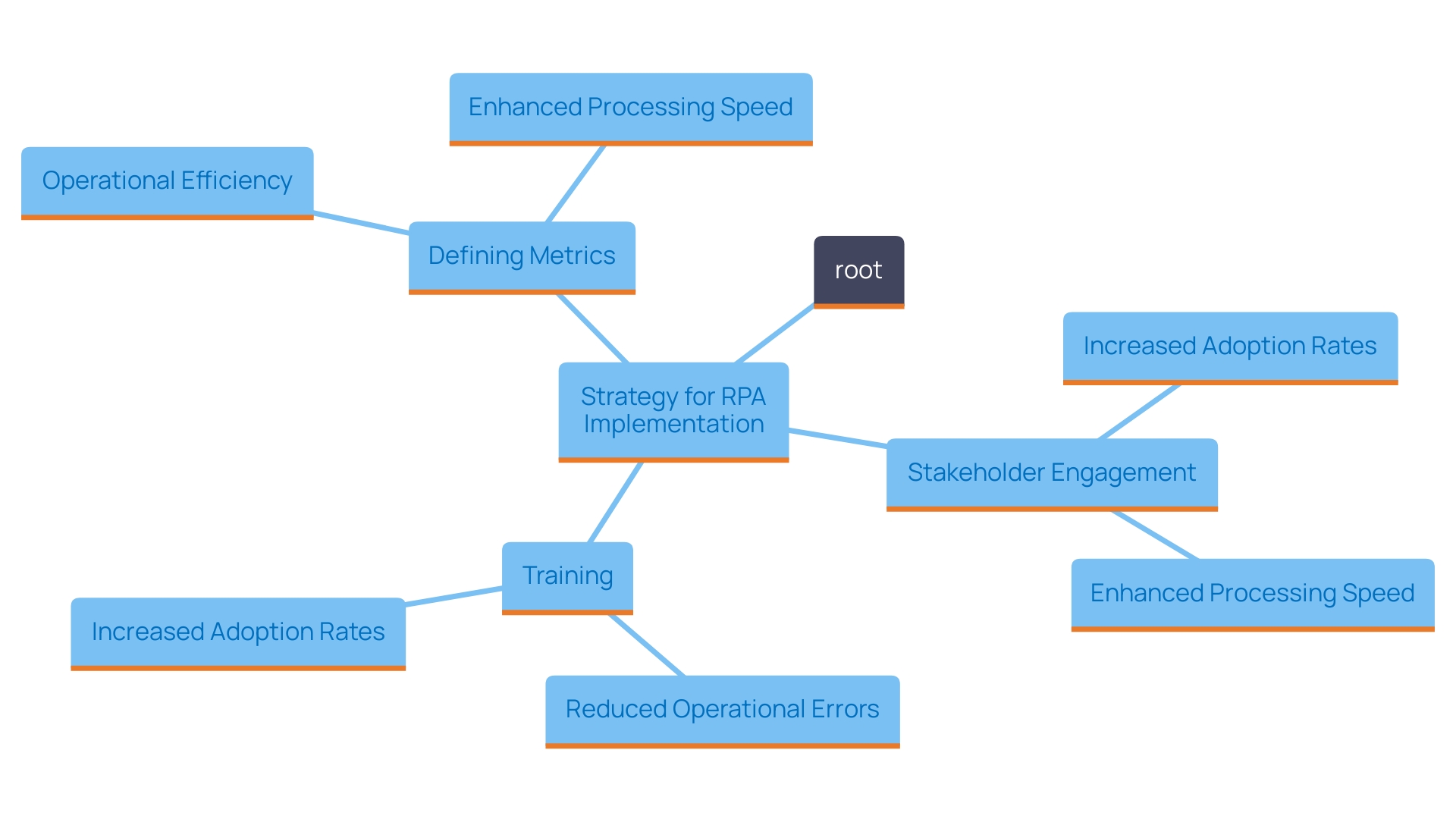
The Role of Metrics in RPA Success
To ensure the success of RPA initiatives, establishing clear metrics to track performance is crucial in addressing common workplace challenges such as staffing shortages, repetitive tasks, and outdated systems. Key performance indicators (KPIs) might include:
- Time Saved: Evaluate how automated tasks reduce the time needed compared to manual efforts. For instance, the DOBOT CR series robot arms can pick and place seven boxes in just one minute, demonstrating significant time savings that can enhance overall operational efficiency.
- Error Rate: Monitor the frequency of errors in automated processes versus manual ones. A lower error rate in automation signifies enhanced accuracy and reliability, which directly contributes to improved operational outcomes.
- Cost Savings: Assess the financial impact of RPA on operational costs, including reductions in labor expenses and increased efficiency leading to higher profitability. By modernizing processes with RPA solutions, entities can streamline workflows and free up their teams for more strategic, value-adding work.
Additionally, the quality of hardware is a critical metric for assessing robot efficiency, as it influences both reliability and maintenance needs. By considering hardware quality, companies can ensure the successful deployment and operation of collaborative robots in industrial tasks. Regularly reviewing these metrics enables entities to identify areas for improvement and validate the effectiveness of their RPA solutions, ensuring alignment with overarching business goals and enhancing productivity through tailored AI solutions and business intelligence for informed decision-making.
Moreover, the importance of robust performance metrics in driving RPA success is underscored by industry experts. As highlighted, ‘Like MongoDB with vector search, investors and users are waiting to see what Datadog—which is already deeply entrenched in enterprises—does in AI observability and evaluation.’ This quote emphasizes the need for comprehensive metrics not only in evaluating RPA performance but also in maintaining competitiveness in a rapidly evolving landscape.
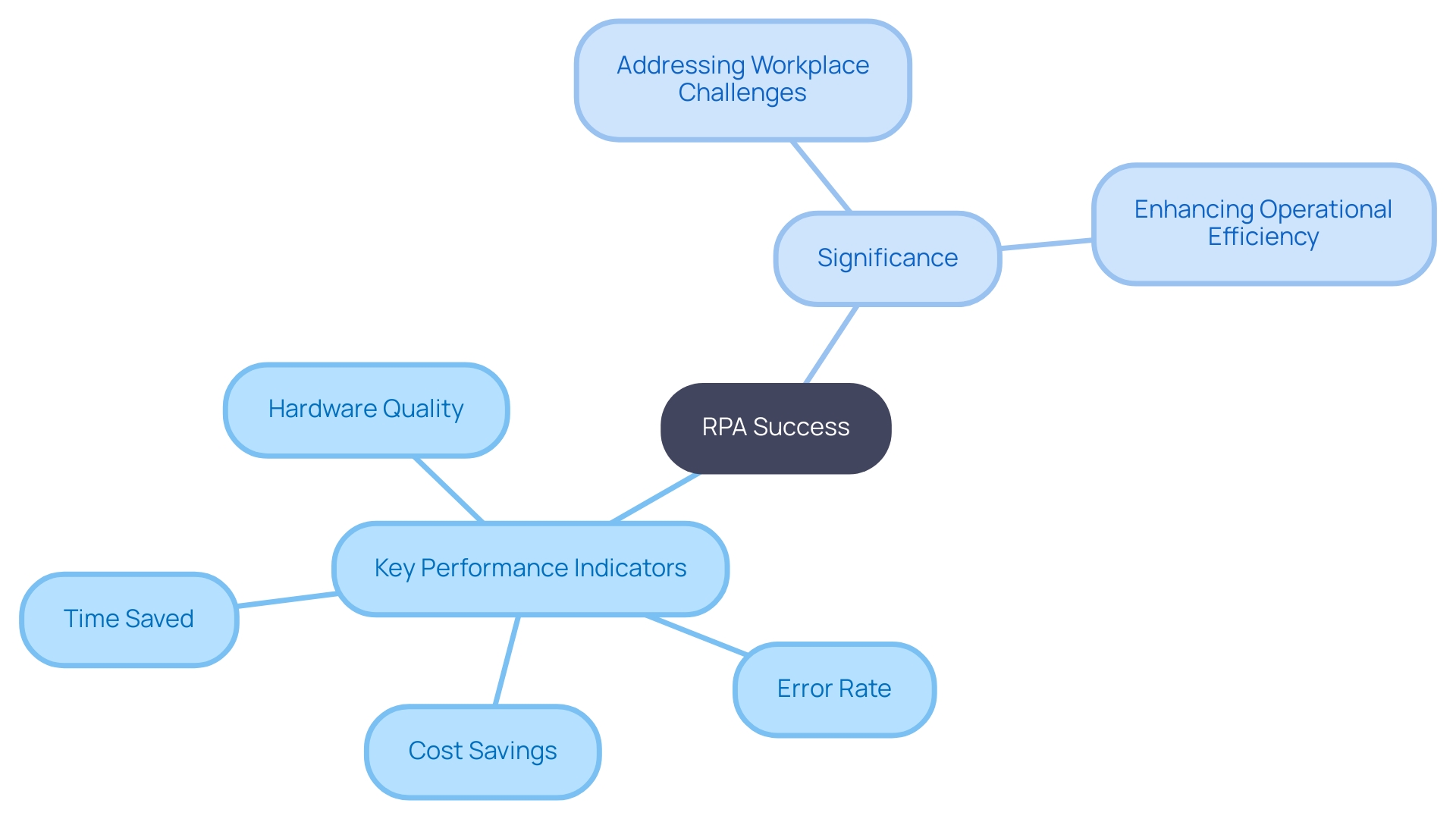
Future Trends in RPA Technology
As RPA technology continues to advance, several key trends are shaping the future landscape of automation:
-
Integration with Artificial Intelligence: The fusion of RPA and AI is ushering in an era of intelligent automation. This convergence enables systems to perform complex decision-making tasks, significantly enhancing operational efficiency. For instance, UiPath’s RPA solution has demonstrated up to 80% faster reconciliation times and double the transaction processing capacity compared to traditional methods. This efficiency not only streamlines operations but can also result in substantial cost savings for entities.
-
Enhancing Business Productivity: RPA can automate manual workflows, significantly reducing the time spent on repetitive tasks, thereby freeing up teams to focus on strategic initiatives that drive growth. In today’s data-rich environment, leveraging RPA alongside tailored AI solutions and Business Intelligence empowers entities to make informed decisions that propel innovation.
-
Increased Focus on User Experience: Future RPA solutions are set to prioritize user-friendly interfaces, making them more accessible and easier to adopt. By enhancing usability, companies can ensure smoother integration and greater acceptance among employees, which is crucial for successful implementation.
-
Cloud-Based RPA Solutions: The shift towards cloud computing is facilitating the scalability of RPA solutions. Cloud-based platforms provide advanced features and enhanced flexibility, enabling organizations to broaden their capabilities more effectively. This scalability is especially crucial as companies expand and their operational needs change.
Moreover, case studies reveal that many enterprises face challenges in RPA adoption due to error amplification and the need for robust use cases. RPA suppliers are progressively partnering with clients to pinpoint opportunities for efficiency, resulting in the creation of pilot projects that showcase the potential of RPA. This collaborative approach guarantees that businesses have a solid foundation for their operational strategies.
Staying informed about these trends is crucial for organizations aiming to harness the full potential of RPA technologies. As Marina Bill, President of the International Federation of Robotics, emphasizes, ‘The five mutually reinforcing technological trends in 2024 demonstrate that robotics is a multidisciplinary field where technologies are converging to create intelligent solutions for a wide range of tasks.’ Embracing these advancements will position businesses to thrive in the competitive landscape of digital transformation.
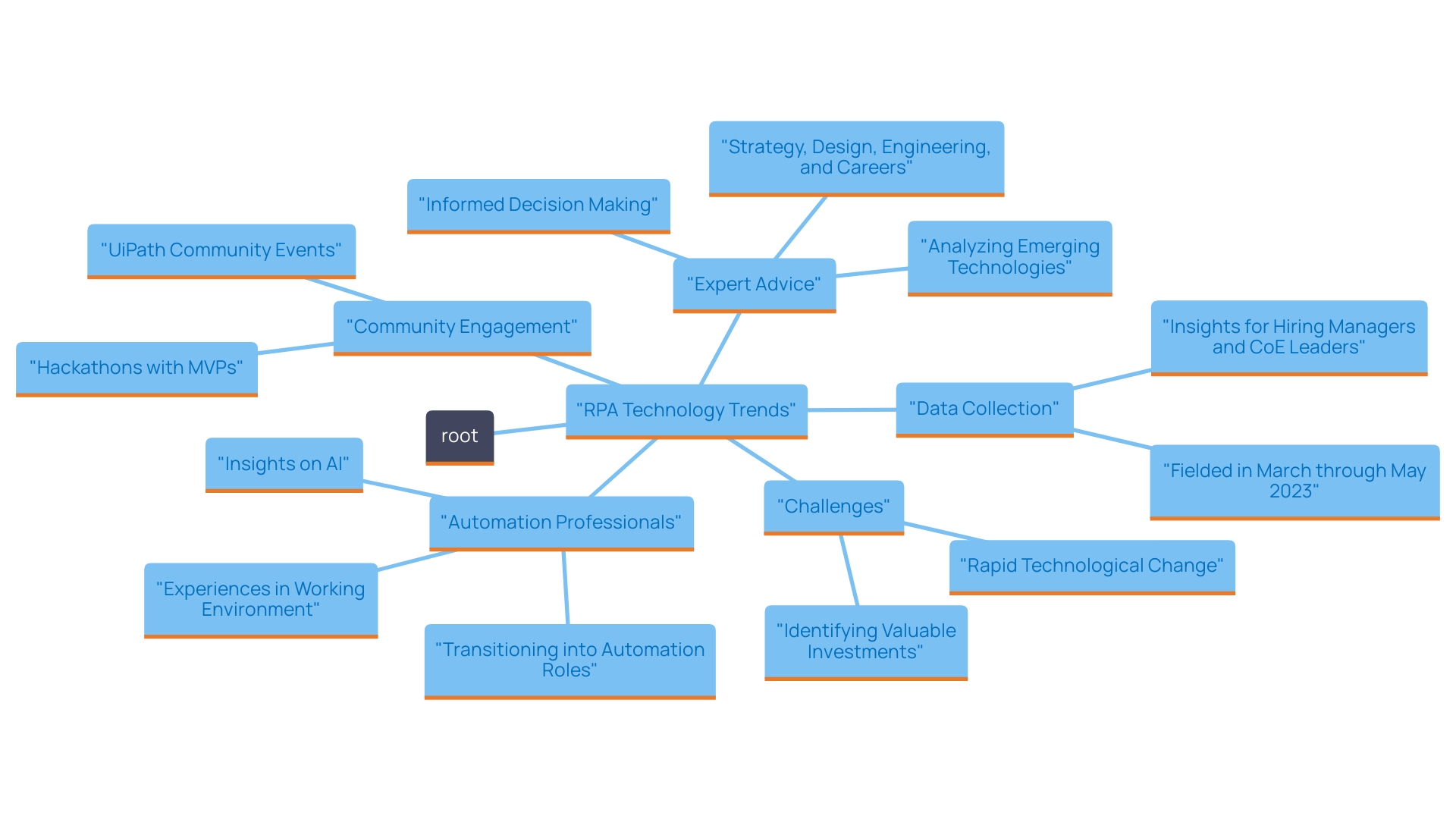
Building a Culture of Automation
To fully utilize the advantages of Robotic Process Automation (RPA), entities need to foster a culture that wholeheartedly accepts automated processes.
-
Education and Awareness: Continuous education on RPA’s benefits is crucial. Highlighting how RPA can enhance human work rather than replace it can alleviate fears and boost acceptance. According to recent statistics, organizations that prioritize education and awareness see significantly higher rates of RPA adoption. For instance, in 2024, it’s projected that companies with strong educational initiatives will achieve a 30% increase in technology adoption rates compared to those that do not invest in such programs. Tailored AI solutions can play a pivotal role in this education by providing targeted technologies that align with specific business goals, such as customized training modules that demonstrate RPA’s effectiveness in various scenarios.
-
Celebrate Successes: Acknowledging and celebrating successful projects can create a ripple effect of enthusiasm and support for future initiatives. For instance, the case study of Databricks Cluster Creation showcases how overcoming initial challenges through proper formatting and adjustments led to successful outcomes, reinforcing the value of persistence and innovation. By sharing these successes, such as a 25% reduction in processing time achieved through RPA in the finance department, organizations can demonstrate the tangible benefits of RPA and its role in enhancing productivity.
-
Encourage Innovation: Fostering an environment where employees feel empowered to propose streamlined processes and innovate continuously is key. As Jessica Hill highlights, ‘An Azure Databricks Notebook is a powerful data science tool that supports exploratory data analysis, hypothesis testing, data cleaning and transformation, data visualization, statistical modeling, and machine learning.’ This insight underscores the importance of equipping teams with the right tools and encouraging them to explore new possibilities. Leveraging business intelligence can further aid in transforming raw data into actionable insights, enabling informed decision-making that drives growth.
By actively fostering a culture of mechanization, groups can significantly boost employee involvement and guarantee a smoother transition to automated processes. Such an approach not only drives efficiency but also creates a more dynamic and forward-thinking workplace. In summary, organizations should focus on education, celebrate successes, and foster innovation to build a robust culture of automation that propels them toward a successful digital transformation.
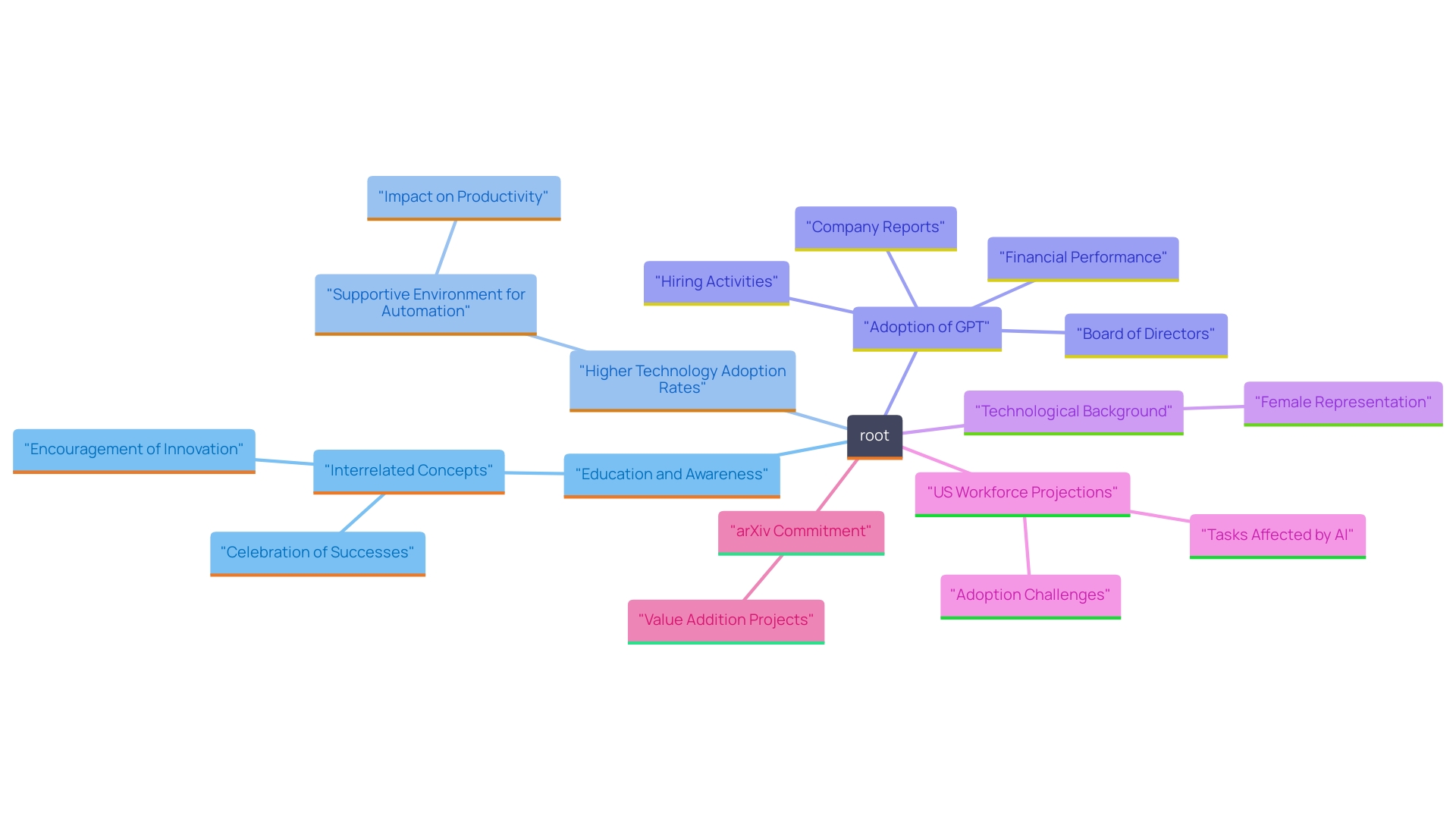
Conclusion
Embracing Robotic Process Automation (RPA) is not merely a trend; it is a strategic necessity for organizations aiming to enhance operational efficiency and drive productivity. The article has outlined the critical stages of the RPA lifecycle, from identifying suitable processes for automation to ensuring continuous monitoring post-implementation. By understanding and meticulously following this lifecycle, organizations can align RPA solutions with their business objectives, ultimately leading to substantial improvements in workflow efficiency and accuracy.
The challenges associated with RPA implementation, such as resistance to change and technical issues, can be effectively mitigated through proactive stakeholder engagement, comprehensive training, and the establishment of clear metrics. These actions empower employees and facilitate a smoother transition to automation, reinforcing the notion that RPA is a tool for human enhancement rather than replacement. Furthermore, the significance of robust performance metrics cannot be overstated, as they provide actionable insights that drive informed decision-making and validate the effectiveness of RPA initiatives.
As the landscape of RPA technology continues to evolve, organizations must stay ahead of emerging trends, such as the integration of artificial intelligence and the shift toward cloud-based solutions. By fostering a culture of automation that prioritizes education, celebrates successes, and encourages innovation, businesses can position themselves for sustained growth and competitiveness in a rapidly changing environment. The journey towards automation is not just about adopting new technologies; it is about transforming organizational mindsets and practices to fully leverage the benefits that RPA has to offer.